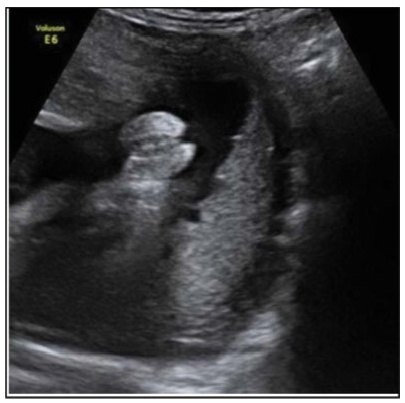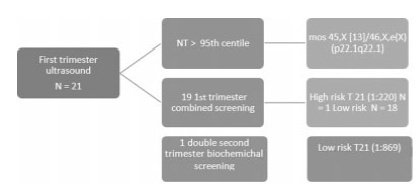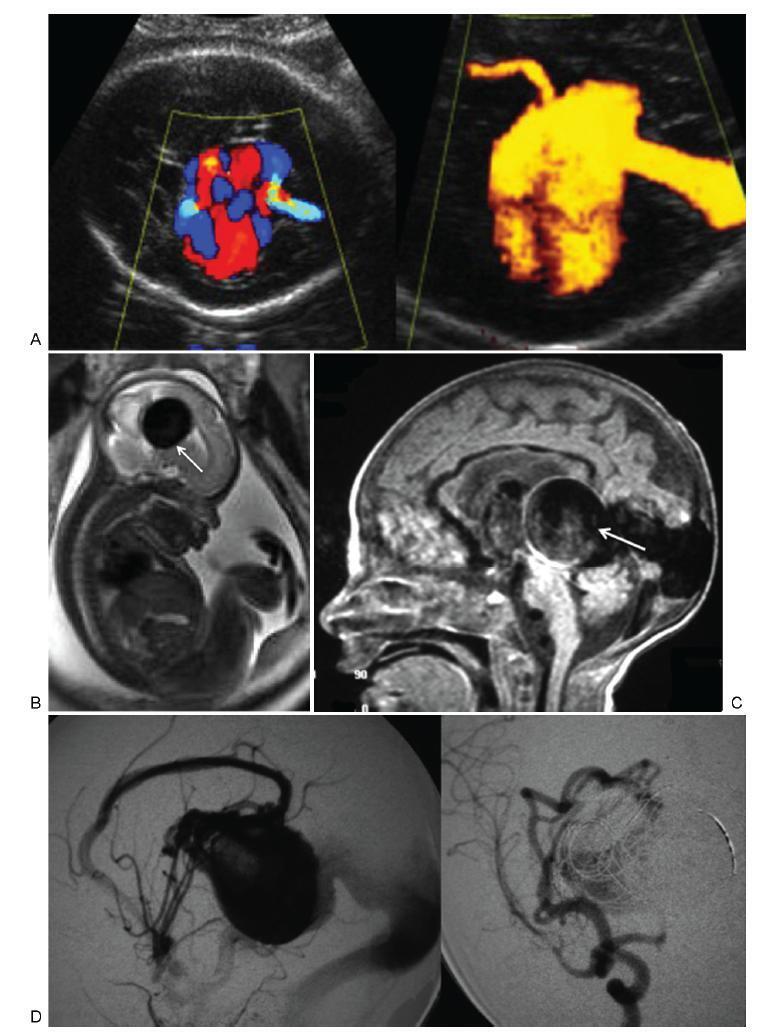Summary
Rev Bras Ginecol Obstet. 2021;43(9):710-712
With the widespread uptake of noninvasive prenatal testing (NIPT), a larger cohort of women has access to fetal chromosomal sex, which increases the potential to identify prenatal sex discordance. The prenatal diagnosis of androgen insensitivity syndrome (AIS) is an incidental and rare finding. We wish to present the diagnosis of a prenatal index case after NIPT of cell-free fetal DNA and mismatch between fetal sex and ultrasound phenotype. In this particular case, the molecular analysis of the androgen receptor (AR) gene showed the presence of a pathogenic mutation, not previously reported, consistent with complete androgen insensitivity syndrome. Carrier testing for the mother revealed the presence of the same variant, confirming maternal hemizygous inheritance. Identification of the molecular basis of these genetic conditions enables the preimplantation or prenatal diagnosis in future pregnancies.

Summary
Rev Bras Ginecol Obstet. 2021;43(6):452-456
The objective of the present study was to determine the frequency of malformations and chromosomal abnormalities in a population of fetuses with an aberrant right subclavian artery (ARSA).
This is a 6-year retrospective study of fetuses with a prenatal diagnosis of ARSA conducted during the period between September 2013 and June 2019 at a fetal medicine unit. Data were collected from ultrasound, fetal echocardiograms, genetic studies, and neonatal records.
An ARSA was diagnosed in 22 fetuses. An ARSA was an isolated finding in 18 out of 22 cases (82%). Associated abnormal sonographic findings were found in 4 cases. All cases underwent invasive testing. In 1 of the cases, a chromosomal abnormality was detected (mos 45,X [13]/46,X,e(X) (p22.1q22.1)). No cases of congenital heart disease were found in any of these fetuses. There were two cases in which the postnatal evaluation revealed amalformation: one case of hypospadias and 1 case of cleft palate.
The presence of an isolated ARSA is benign and is not associated with chromosomal abnormalities. The finding of ARSA, however, warrants a detailed fetal ultrasound in order to exclude major fetal abnormalities and other soft markers.

Summary
Rev Bras Ginecol Obstet. 2021;43(5):351-356
Most prenatal screening programs for toxoplasmosis use immunoassays in serum samples of pregnant women. Few studies assess the accuracy of screening tests in dried blood spots, which are of easy collection, storage, and transportation. The goals of the present study are to determine the performance and evaluate the agreement between an immunoassay of dried blood spots and a reference test in the serum of pregnant women from a population-based prenatal screening program for toxoplasmosis in Brazil.
A cross-sectional study was performed to compare the immunoassays Imunoscreen Toxoplasmose IgM and Imunoscreen Toxoplasmose IgG (Mbiolog Diagnósticos, Ltda., Contagem, Minas Gerais, Brazil)in dried blood spots with the enzymelinked fluorescent assay (ELFA, BioMérieux S.A., Lyon, France) reference standard in the serum of pregnant women from Minas Gerais Congenital Toxoplasmosis Control Program.
The dried blood spot test was able to discriminate positive and negative results of pregnant women when comparedwith the reference test, with an accuracy of 98.2% for immunoglobulin G (IgG), and of 95.8% for immunoglobulin M (IgM).
Dried blood samples are easy to collect, store, and transport, and they have a good performance,making this a promisingmethod for prenatal toxoplasmosis screening programs in countries with continental dimensions, limited resources, and a high prevalence of toxoplasmosis, as is the case of Brazil.
Summary
Rev Bras Ginecol Obstet. 2020;42(12):805-810
To analyze the most frequent referrals for fetal echocardiography, including advanced maternal age and its association with abnormal results.
We included all pregnant women referred to perform fetal echocardiography (gestational age 22-32 weeks) in 2 health centers in Rio de Janeiro, from June 2015 to June 2016. Advanced maternal age was considered when age was > 35 years at the time of delivery). Referral reasons and results were recorded, according to the Brazilian Fetal Cardiology Statement. Crude and adjusted prevalence ratios were calculated (Poisson regression). We considered p < 0.05 as significant.
A total of 1,221 tests were analyzed. Abnormal fetal echocardiography was observed in 14.82% of the cases. The most frequent abnormalities were interventricular septal defect (6.39%), septal hypertrophy (3.35%) and atrioventricular septal defect (1.14%). Routine exams were performed in 559 women, 289 were referred for advanced maternal age and 373 were referred according to the Brazilian FetalCardiology Statement criteria. An obstetric ultrasound suggesting fetal cardiacabnormality, maternal diabetes, increased nuchal translucency, and obstetric ultrasound suggesting a noncardiac abnormality were strongly associated with an abnormal fetal echocardiography. Abnormal results were not more frequent in women with advanced maternal age when compared with the rest of the study group.
It was observed that routine exams and advancedmaternal age referrals were very frequent. Those exams were not associated to fetal echocardiography abnormalities. In this scenario, when the obstetric ultrasound suggests a fetal cardiac
Summary
Rev Bras Ginecol Obstet. 2020;42(4):188-193
To evaluate the frequency of structural congenital anomalies (CAs) in the midwest of Brazil and its association with maternal risk factors.
This was a prospective, observational, case-control study based on a hospital population. Pregnant women attended at a fetal medicine service in Brazil were analyzed in the period from October 2014 to February 2016.A total of 357 pregnant women were included, 223 of whom had fetuses with structural anomalies (group case), and 134 of whom had structurally normal fetuses (control group). The clinical history was made previous to prenatal consultation, and the diagnosis of the structural CA was performed through ultrasound.
A frequency of 64.27% (n = 223) of pregnant women with fetuses with structural anomalies was observed. The most frequent structural CAs were those of the central nervous system (30.94%), followed by anomalies of the genitourinary system (23.80%), and, finally, by multiple CAs (16.60%). The background of previous children with CAs (odds ratio [OR]: 3.85; p = 0.022), family history (OR: 6.03; p = < 0.001), and consanguinity between the progenitors (OR: 4.43; p = 0.034) influenced the occurrence of structural CA.
The most frequent CAs are those of the central nervous system, followed by those of the genitourinary system, and then multiple anomalies. The maternal risk factors that may have influenced the occurrence of structural CA were previous children with CA, family history, and consanguinity among the parents.
Summary
Rev Bras Ginecol Obstet. 2020;42(4):228-232
The present report describes a case of complete atrioventricular block (CAVB) diagnosed at 25 weeks of gestation in a pregnant woman with Sjögren's syndrome and positive anti-Ro/SSA antibodies. Fluorinated steroids (dexamethasone and betamethasone) and terbuline were used to increase the fetal heart rate, but the fetal heart block was not reversible, and the administration of drugs was discontinued due to maternal collateral effects. Follow-up fetal echocardiograms were performed, and the fetus evolved with pericardial effusion, presence of fibroelastosis in the right ventricle, and ventricular dysfunction. Interruption of pregnancy by cesarean section was indicated at 34 weeks of gestation, and a cardiac pacemaker was implanted in the male newborn immediately after birth. Therapy for fetuses with CAVB is controversial mainly regarding the use or not of corticosteroids; however, monitoring of the atrioventricular interval by fetal echocardiography should be performed in fetuses from pregnant women with positive autoantibodies anti-Ro/SSA and/or anti-La/SSB to prevent the progression to CAVB.

Summary
Rev Bras Ginecol Obstet. 2017;39(6):265-272
To evaluate maternal-fetal surveillance and follow-up of infants at risk for congenital syphilis (CS).
Retrospective cohort study in a Portuguese Tertiary Referral Hospital. The main inclusion criterion was a positive syphilis serology. The study included all pregnant women that delivered in our hospital between January 2004 and December 2013. The neonates were classified according to their probability of infection based on the Centers for Disease Control and Prevention guidelines.
Among the 27 pregnancies at risk for CS, 48.2% (n = 13) of the women had a diagnosis during the 1st trimester, and the median gestational age at the end of the treatment was 28 weeks. Inadequate treatment was noted in 44.4% (n = 12) of the women. Adverse pregnancy outcomes were observed in 30.8% of the cases (n = 8), 5 of which had been adequately treated. We found 2 (7.7%) cases with “proven or highly probable CS,” 10 (38.5%) with “possible CS,” 12 (46.1%) with “less likely CS,” and 2 (7.7%) with “unlikely CS.”Among the infants, the treatment was successful, except for 1 neurosyphilis case.
This study highlights many of the difficulties/concerns encountered in the maternal-neonatal management of syphilis. We highlight the importance of assuring the early detection of the infection as a way of guaranteeing the timely treatment, as well as a good compliance to the treatment and follow-up through a more efficient pregnant women surveillance network.
Summary
Rev Bras Ginecol Obstet. 2017;39(6):309-314
To describe the prenatal diagnosis of Galen vein aneurysm (GVA) based on ultrasonography and magnetic resonance imaging (MRI) in a series of cases, as well as its postnatal outcomes and follow-up until 4 years of age.
A retrospective longitudinal study was performed, analyzing a database comprising seven cases of prenatal diagnosis of GVA at two Brazilian institutions from February of 2000 to May of 2012. The following data were evaluated: gestational age at diagnosis, GVA dimensions on ultrasonography, associated fetal changes, findings on fetal echocardiography, gestational age at delivery, type of delivery, birth weight, Apgar score at the 1st and 5th minutes, neonatal outcomes, and survival with follow-up until 4 years of age.
The mean gestational age ± standard deviation on the prenatal diagnosis of GVA based on ultrasonography was 25±4.9 weeks. The mean length of GVA was 3.2±0.4 cm. The mean gestational age at birth was 37.5±0.7 weeks, and a cesarean section was performed in 85.7% of the cases (6/7). The mean birth weight was 3,070±240.4 g. The total survival rate was 42.8% (4/7), with three neonatal deaths. Of the four survivors, three presented with normal neuropsychomotor development until 4 years of age and only one showed serious neurological sequelae. Ultrasonography and MRI showed similar findings for all seven cases.
Galen Vein Aneurysm is associated with a high neonatal death rate. Therefore, its prenatal diagnosis is essential for parent counseling and follow-up at tertiary care institutions.

Search
Search in:
breast (42) breast cancer (42) breast neoplasms (95) Cesarean section (72) endometriosis (66) infertility (56) Maternal mortality (43) menopause (82) obesity (58) postpartum period (40) pregnancy (225) Pregnancy complications (99) Prenatal care (68) prenatal diagnosis (50) Prevalence (41) Quality of life (51) risk factors (94) ultrasonography (79) urinary incontinence (40) women's health (48)